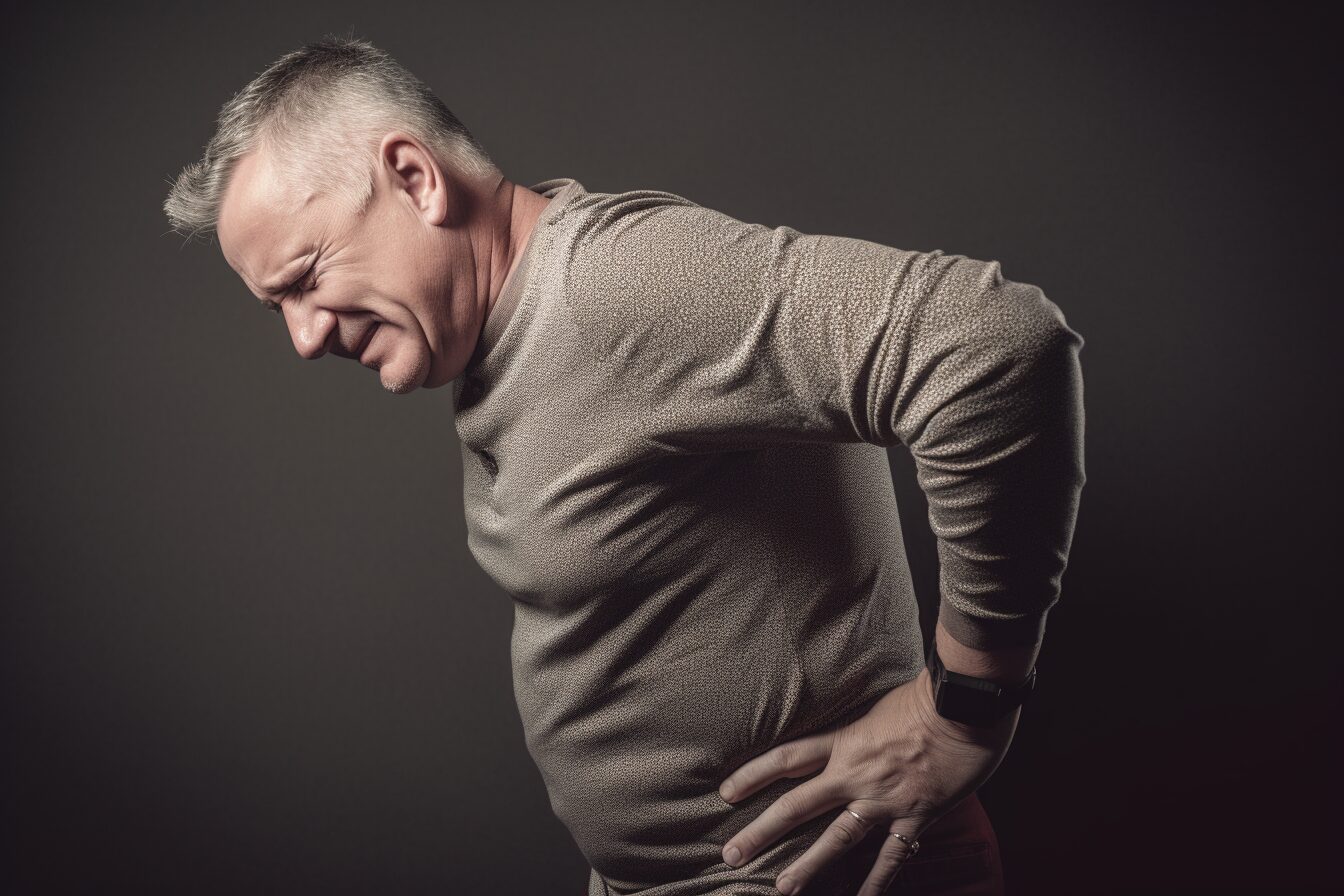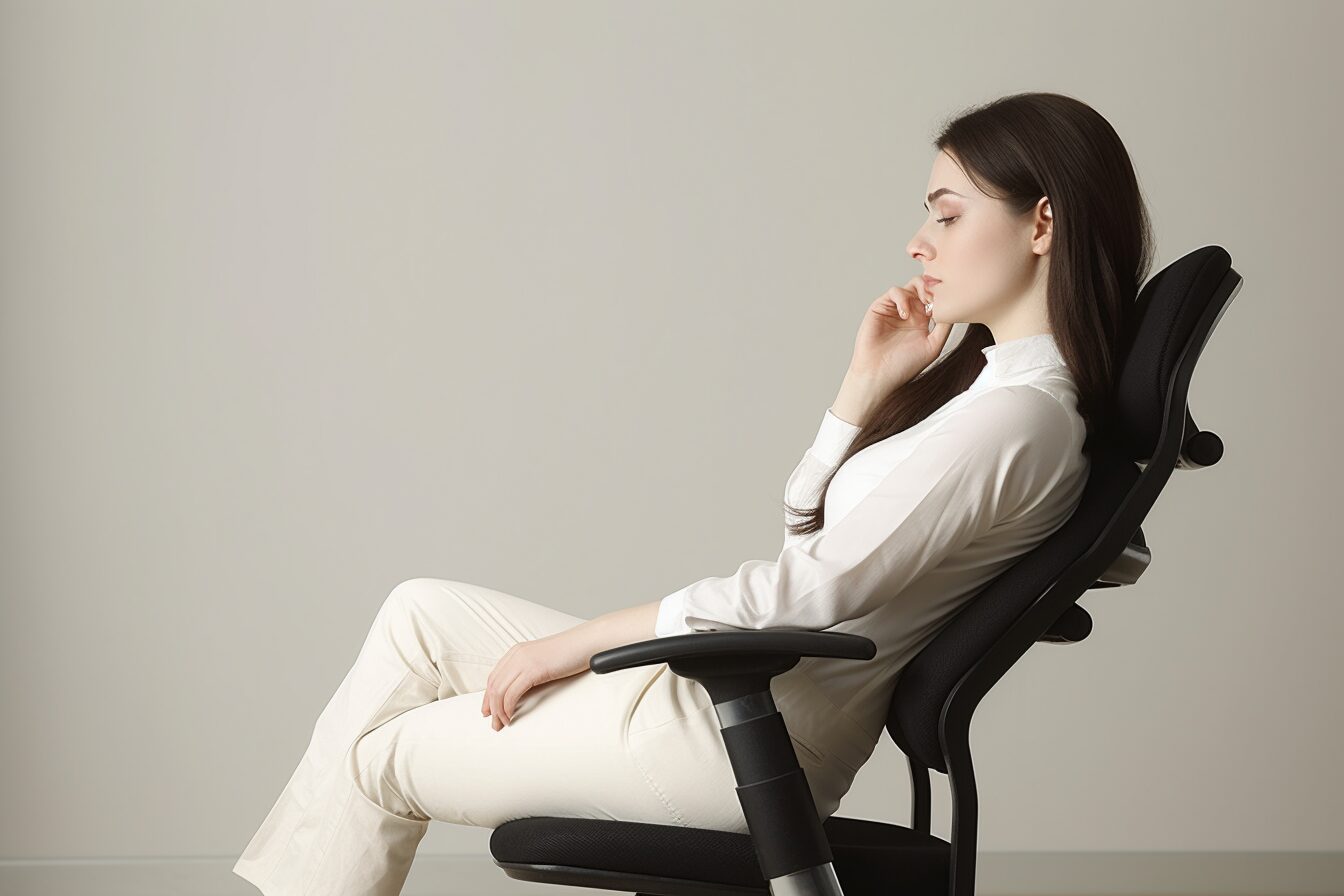Easy Steps: How to Fix Lower Back Pain from Sitting
Imagine sitting at your desk, clocking in those hours, when a creeping sensation starts to take hold of your lower back. It's not just you; this is a tale as old as time for anyone tethered to their chair for work or play. That's why understanding how to fix lower back pain from sitting has become something of a modern-day quest.
Embarking on this exploration, we're set to unravel the mysteries behind that persistent discomfort and discover potent methods for its relief. From tweaking your sitting posture to integrating movement into your daily routine, you're about to get equipped with actionable insights. By the end, not only will you know how to fend off lower back discomfort but also how simple adjustments can significantly enhance spinal health and overall well-being.
Let's embark on this enlightening path together and turn the tide against one of today’s most common conditions—because nobody should have their day overshadowed by preventable pain.
Table Of Contents:
- Understanding Lower Back Pain from Sitting
- Effects of Prolonged Sitting on Spinal Health
- Preventive Measures for Lower Back Pain From Prolonged Sitting
- Treatment Options for Lower Back Pain Due to Sitting
- Incorporating Movement Into Your Routine
- The Role Of Ergonomic Furniture In Preventing Back Pain
- FAQs in Relation to How to Fix Lower Back Pain From Sitting
- Conclusion
Understanding Lower Back Pain from Sitting

Sitting for long periods can be a real pain in the back, literally. When we're parked on our derrieres all day, it puts 40 to 90 percent more stress on our backs than standing does. Why? Let's break it down.
The Role of Disc Pressure in Back Pain
Our spines aren't fans of prolonged sitting because this position increases disc pressure significantly. This extra burden on the lower back quickly paves the way to issues such as herniated discs, making sitting for extended periods a risky habit. Imagine your spinal discs as jelly donuts; too much pressure, and they start to squish outwards, which isn't as tasty as it sounds when it comes to your back health.
Herniated discs are just one piece of the puzzle though. Other common culprits behind that ache include degenerative disc disease and spinal stenosis—a condition where spaces within your spine narrow, pinching nerves and causing pain you wouldn’t wish on anyone.
Chronic Pain and Underlying Conditions
If you've got ongoing lower back issues from sitting too much, there might be more at play than poor posture or an uncomfortable chair. Degenerative disc disease sneaks up over time, wearing down those spinal cushions until every sit-down feels like a trial by fire for your lower back.
In rare cases, these persistent pains could signal something deeper—like sciatica or muscle strains masquerading as mere annoyances when they’re red flags waving frantically for attention.

Subscribe To Dr Mike's MVP Newsletter!
Exclusive content, interesting topics, real insights.

Effects of Prolonged Sitting on Spinal Health
Sitting for hours can feel like a marathon for your back, turning your cozy chair into a perfect storm for spinal health issues. Muscle strain or sprain, hitting the 70% mark in causes of lower back pain when sitting, isn't just about discomfort; it's a sign from your body screaming for movement.
Addressing Poor Sitting Posture
Poor posture isn’t just slouching; it’s an open invitation to chronic pain. When we sit with our shoulders hunched and spine curved, we’re not only straining muscle groups but also inviting disc pressure that’s akin to squeezing stress balls between the vertebrae – except it's less fun and more painful. Techniques to combat this include adjusting your chair height so both feet can rest flat on the floor and ensuring that you take frequent breaks to stretch those legs.
The Role Of Ergonomic Furniture In Preventing Back Pain
Ergonomic furniture doesn't just belong in glossy magazine spreads about trendy offices; they're crucial players on team 'Spine Health'. With chairs designed to support natural curvature and desks that invite standing as much as sitting, these pieces aren’t luxury items but necessities for anyone looking to dodge the bullet of lower back problems caused by bad posture over time.
To make every seated moment count towards better health rather than detract from it, consider integrating ergonomically designed furniture into your workspace layout. This will help relieve pressure points by distributing weight evenly across muscle groups and ensure optimal blood flow - all key factors in keeping both acute and chronic back issues at bay.
Preventive Measures for Lower Back Pain From Prolonged Sitting

If you're clocking in hours at your desk or binge-watching your favorite shows, chances are your lower back isn't thrilled. But fear not. By smartly adjusting your daily habits and the setup of your work area, you'll manage to ward off that annoying back discomfort.
The Magic of Movement
First off, let's talk about getting up and moving. Staying static is no friend to your spine.
Integrating physical activity into your day keeps blood flowing and muscles limber—critical for dodging discomfort. Consider setting a timer as a nudge to take frequent breaks from sitting; even short walks count.
If you're tied to the desk life, make those seated moments less stressful on the spine by ensuring both feet are flat on the ground with knees bent at a right angle—simple yet effective for reducing pressure on the lumbar region.
Ergonomics: Your Spine’s Best Friend
Now, we're shifting focus towards ergonomics, a field dedicated to tailoring work environments to suit the physiological demands of our bodies. An ergonomic chair with proper lumbar support does wonders for maintaining good posture without effort (goodbye slouch.). Pair it with an adjustable standing desk and watch how quickly this dynamic duo revolutionizes how you feel during those long periods glued to screens.
Bolster Your Core Without Breaking A Sweat
Last but not least: core strength plays an unsung hero role in supporting lower backs comfortably through endless meetings or marathon gaming sessions. To fend off future flare-ups consider incorporating exercises targeting these muscle groups into your daily routine—a stronger core equals better spinal alignment which translates directly into happier backs all around.
Key Takeaway:
Mix movement, ergonomic setups, and core strengthening into your daily routine to fend off lower back pain from sitting too long. Simple changes can make a big difference for your spine's happiness.
Treatment Options for Lower Back Pain Due to Sitting
If you're stuck in a chair all day, feeling like your lower back is about to stage a mutiny, welcome to the club. Let's talk real solutions—no fluff.
Physical Therapy: Not Just Exercise on Steroids
Think of physical therapy as your personal boot camp for pain relief. It's not just doing squats and calling it a day; it’s about personalized exercises that target those rebellious muscle groups causing you grief. Guided by professionals, physical therapy enhances the resilience of your central muscles, ameliorating your stance and diminishing stress on your backbone.
But don't expect overnight miracles—it's more like slow magic that works over time.
The Cold Hard Truth About Ice Packs
An ice pack isn’t just for athletes or boo-boos from playing tag with the coffee table. Applying an ice pack to your lower back can reduce inflammation and numb the area faster than you can say "frozen peas." Short-term use immediately after you experience pain can be surprisingly effective at giving discomfort to the cold shoulder.
Popping Pills? Let’s Talk Over-the-Counter Medication
Sometimes, when tweaking your lifestyle or icing doesn't cut it, nonsteroidal anti-inflammatory drugs (NSAIDs) step into the ring. They tackle inflammation head-on which is often behind that gnawing pain in your lumbar region. Remember though—they’re best used sparingly as part of an overall treatment plan discussed with a healthcare provider, not as solo fighters against chronic conditions.
Battling lower back pain caused by too much sitting involves understanding both why we hurt and how we heal—not just reaching for quick fixes but making informed choices toward long-term comfort and mobility.
Incorporating Movement Into Your Routine

Ever felt like your spine's throwing a tantrum because you've been glued to your chair for what feels like an eternity? Well, it's time to befriend movement and let it sprinkle some magic on that grumpy lower back. Here’s how adding physical activity can transform prolonged sitting into less of a pain in the back.
Blood Flow: The Unsung Hero
First off, getting blood flow jazzed up is crucial. Think of your blood as the FedEx of oxygen and nutrients—it needs clear roads to make timely deliveries to those hardworking muscles. Sitting too long clogs these roads worse than rush-hour traffic.
But here’s a fix: An exercise routine, even if it's just short walks or stretching every hour, keeps traffic moving smoothly.
A little goes a long way; this isn't about transforming into an Olympic athlete overnight but making small tweaks that add up.
The Chair Saga: Making It Ergonomic
Your chair might feel comfy but is it supporting you right? Adjusting chair height so your feet rest flat on the ground with knees bent at around 90 degrees does wonders for alignment. Lumbar support plays its part by maintaining that gentle arch in your lower back—kissing goodbye to slouchy habits.
This doesn’t mean breaking the bank on fancy equipment; sometimes, a rolled-up towel does the trick.
Dancing Feet: Keep Them Flat and Happy
Last but not least, don't underestimate where you plant those feet. By maintaining a flat footing, we foster stability starting from the earth beneath us, which in turn alleviates stress throughout our spinal column. With these tricks tucked under our belts (or rather sat upon), we're setting ourselves up for happier backs despite our desk-bound destinies.
Incorporating workouts into our everyday existence is crucial for extending not just our own lifespan but also that of our dependable vertebral allies.
Key Takeaway:
Transform your desk-bound routine with simple moves. Jazz up blood flow, tweak your chair for support, and keep your feet flat to ease lower back woes. It's all about small changes for a happier spine.
The Role Of Ergonomic Furniture In Preventing Back Pain
Ergonomic furniture isn't just a fancy office perk. It's your spine's best friend, especially if you're among the many people working long hours at a desk. Opting for an ergonomic chair and desk can revolutionize your comfort, alleviating discomfort and ensuring your spine remains content.
Lumbar Support: The Backbone of an Ergonomic Chair
Diving into the essence of comfort and posture, lumbar support stands as a pivotal element in ergonomic seating, aiming to echo the natural arch of your spine. This feature in ergonomic chairs mimics the natural curve of your lower back, providing crucial support where it’s needed most. Sitting without proper support forces the spine into a slouched position, putting unnecessary strain on its structures and leading to discomfort or even chronic issues over time.
Adjusting chair height is another key factor in maintaining good posture while seated. Your feet should rest flat on the floor with knees bent at about a 90-degree angle to reduce pressure on your spinal cord—a straightforward adjustment that can significantly lessen discomfort throughout the day.
Moving Beyond Static Sitting
Sitting still for too long is never ideal, no matter how comfortable your chair might be. Integrating movement into your routine helps keep blood flowing and muscles engaged—essential factors for reducing pain associated with prolonged sitting periods.
An exercise routine doesn’t have to mean hitting the gym during every break either; simple stretches or walking around periodically will do wonders for keeping stiffness at bay.
Delve into resources offered by UNC Workplace Safety and UCLA Health Spine Center for advanced strategies on enhancing office ergonomics to alleviate the discomfort stemming from extended periods of sitting.
FAQs in Relation to How to Fix Lower Back Pain From Sitting
How do I stop my lower back from hurting when I sit?
To dodge the ache, adjust your chair for lumbar support and keep feet flat. Break up sitting with short walks.
Why is my lower back pain worse after sitting down?
Sitting too long ups disc pressure in your spine, sparking more pain. Shift positions often to ease it.
What is the fastest way to relieve lower back pain at home?
An ice pack followed by a heating pad works wonders. Also, stretching gently can loosen things right up.
How do you tell if lower back pain is muscle or disc?
If twisting hurts but straight movements don't, likely it's a muscle issue. Sharp pains bending forward suggest a disc problem.
Conclusion
Wrapping up, knowing how to fix lower back pain from sitting starts with understanding its causes. Exploring the damage that slouching for too long does to our backs has illuminated the path forward.
Tackling the issue head-on means making small yet impactful changes. Adjust your chair height, keep those feet flat, and take frequent breaks to stand or stretch. These actions not only relieve pain but also promote better blood flow.
Incorporate exercises that strengthen core muscles into your routine. This goes beyond mere comfort; it's about crafting a robust backbone for enduring back wellness.
If pain persists, remember: seeking help from a healthcare provider is crucial. They can offer tailored advice or treatment options beyond what we've covered here.
At day's end, it's about taking charge of your well-being. Start now; because no one should let preventable pain dim their light.
18600 Main St STE 110, Huntington Beach, CA 92648

Subscribe To Dr Mike's MVP Newsletter.
Get In Touch
(714) 794-2171
Office Hours
Monday-Thursday:
7:00 am - 11:00 am, 2:00 pm - 6:00 pm
Friday: Closed
Saturday: By Appointment Only
Sunday: Closed

(714) 794-2171
Subscribe To Dr Mike's MVP Newsletter.
Office Hours
Monday-Thursday:
7:00 am - 11:00 am, 2:00 pm - 6:00 pm
Friday: Closed
Saturday: By Appointment Only
Sunday: Closed
18600 Main St STE 110, Huntington Beach, CA 92648
Huntington Beach Chiropractic | Copyright ©2025 | Website by iTech Valet
